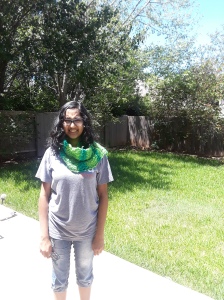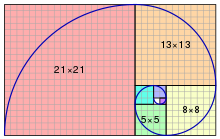The first time I ever picked up a Crochet needle was 6 years ago, in an attempt to improve my terrible hand-eye coordination. I started off with a task that was deemed easy by many crochet gurus on YouTube: crocheting a scarf. But the scarf turned out to be REALLY hard, so I turned that project into a purse and gave it away to one of my best friends on her birthday.
Flash forward to yesterday, I was sitting in my room trying to find ways to procrastinate on my first week of school homework. In a desperate attempt, I decided to clean my closet out (Yes I really did not feel like working :)). While cleaning out my closet I found my old crochet needle stuck in a bright-green ball of yarn, just waiting to be used. Huh…I wonder if I still remember how to crochet? I thought to myself. In school, we had just been given a talk on CAS, and I thought this was the perfect time to revisit an old hobby that I had given up on all those years ago.
I wanted to start off with an easy project, as I had not crocheted in a long time. I also wanted to create a scarf, to prove that I could figure out how to do it in spite of the past failure. While looking for projects, I came across a really interesting article that talked about the mathematics involved in Crocheting. It discussed Hyperbolic Planes, Geometry Conjectures, Fractals, and different Dimensions all modeled through crocheting. All of the projects however, were very difficult, but so cool!!! My inner Math Geek was thrilled! A little part of the article mentioned how interesting number sequences can be represented as visually stimulating designs in crochet.
The first number sequence my brain jumped to was the Fibonacci sequence, as we had just done an activity regarding that sequence in my Physics class. There has got to be a Fibonacci Sequence scarf on the Internet! I thought to myself. And there was! That is how I ended up channeling my inner Math Geek and crocheting a Fibonacci Sequence inspired scarf!

So first for the Math lesson…Who exactly is Fibonacci and why is his sequence so important?
Fibonacci was a famous Italian mathematician who is credited for popularizing the Hindu-Arabic number system (0,1,2,3,4,5…) as opposed to the Roman Numeral system that was being used at the time! We should all be so thankful to him…I can’t imagine doing any comprehensive math with Roman Numerals!
Anyway, he came up with a sequence that has a continues with the addition of the previous 2 numbers. 0+1=1, 1+1=2, 1+2=3, 2+3=5, 3+5 = 8. The sequence would be 0,1,1,2,3,5,8….and continue forever. This sequence is so important and well-known, because it pops up literally everywhere! The pattern of the Fibonacci sequence can modeled through a spiral, which can be seen in many natural habitats. In fact, pine cones, tree branches, snail shells, uncurling fern, and artichokes all follow this spiraled pattern!

Technology wise, there is a search algorithm relating to the Fibonacci sequence, and data structures inspired from it! In Math, this sequence appears in random places and is closely related with other patterns. For instance, this sequence is closely tied to the Golden Ratio and Lucas numbers! Sorry for all the exclamation marks…I love learning about the beautiful Fibonacci sequence! In fact, think this is my favorite number sequence EVER :).
In Art, the Fibonacci sequence is used by many to create visually stimulating designs. This same principle appears in Crochet. When crocheting, there is many different ways you can represent the Fibonacci sequence. However, I decided to do a striped pattern on a scarf, as a beginning project. Check out the pattern and tutorial down below!
PATTERN:
Fibonacci Pattern
Constant
7 rows of color A
1 row of color B
7 rows of color A
1 row of color B
7 rows of color A
2 rows of color B
7 rows of color A
3 rows of color B
7 rows of color A
5 rows of color B—SAME PATTERN MIRRORED ON OTHER SCARF SIDE
7 rows of color A
5 row of color B
7 rows of color A
3 row of color B
7 rows of color A
2 row of color B
7 rows of color A
1 row of color B
7 rows of color A
1 row of color B
STEPS:
- Gather materials: A crochet needle (I am using a size K 6.50mm one) and 2 balls of yarn in contrasting colors.
- Make a slip knot with the yarn color that you want to stay constant. This is the first step for anyone starting a crochet project. The yarn you are working with should be attached to the ball, not free floating or cut.
- Start by crocheting an odd number of loose chains. I did 25, which was about 7 inches long. You can do any number you want for different widths. The widths will vary based upon the type of needle and yarn you are using.
- Add one more chain stitch than the number you want. In my case, it would be 26.
- Put your needle holding that chain stitch in the second chain from your needle.
- Proceed to make a single crochet (SC), and after in that same chain, make a double crochet (DC). When SC and DC are used together in the same chain, it is called a seed stitch.
- Finish the row. Add a new chain, and start again! Repeat this until you have finished number of rows that you want to stay constant.
- Now it is time to change colors! Follow the same Seed Stitch.
- With this yarn color, you will be creating rows based on the Fibonacci sequence. I did 1,1,2,3, and 5.
- After you are done with the sequence number, you do the same steps, but mirror it on the other side. AKA 5,3,2,1,1.
- YAY!!! Now you have a finished Fibonacci scarf!


Cool!! I can’t wait to see it in person!
LikeLike
Thanks! I have more crocheting and math projects planned that I will definitely be wearing to school during the winter :).
LikeLike